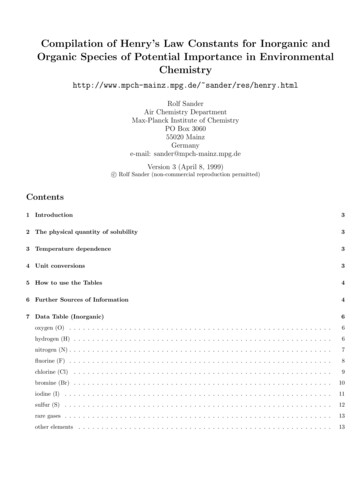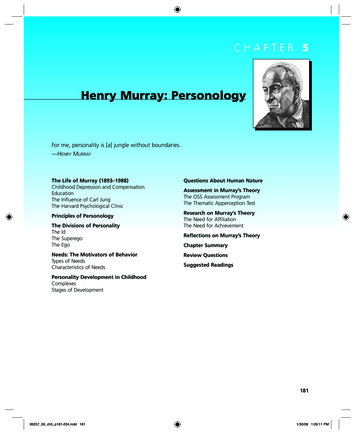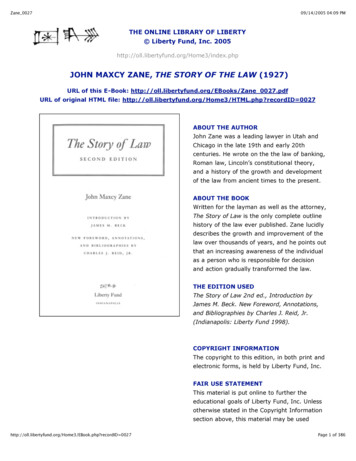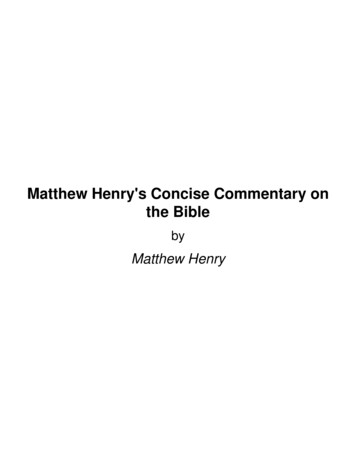
Transcription
Compilation of Henry’s Law Constants for Inorganic andOrganic Species of Potential Importance in / sander/res/henry.htmlRolf SanderAir Chemistry DepartmentMax-Planck Institute of ChemistryPO Box 306055020 MainzGermanye-mail: sander@mpch-mainz.mpg.deVersion 3 (April 8, 1999)c Rolf Sander (non-commercial reproduction permitted)Contents1 Introduction32 The physical quantity of solubility33 Temperature dependence34 Unit conversions35 How to use the Tables46 Further Sources of Information47 Data Table (Inorganic)6oxygen (O) . . . . . . . . . . . . . . . . . . . . . . . . . . . . . . . . . . . . . . . . . . . . . . . . . . . . . . . . .6hydrogen (H) . . . . . . . . . . . . . . . . . . . . . . . . . . . . . . . . . . . . . . . . . . . . . . . . . . . . . . . .6nitrogen (N) . . . . . . . . . . . . . . . . . . . . . . . . . . . . . . . . . . . . . . . . . . . . . . . . . . . . . . . . .7fluorine (F) . . . . . . . . . . . . . . . . . . . . . . . . . . . . . . . . . . . . . . . . . . . . . . . . . . . . . . . . .8chlorine (Cl) . . . . . . . . . . . . . . . . . . . . . . . . . . . . . . . . . . . . . . . . . . . . . . . . . . . . . . . .9bromine (Br) . . . . . . . . . . . . . . . . . . . . . . . . . . . . . . . . . . . . . . . . . . . . . . . . . . . . . . . .10iodine (I) . . . . . . . . . . . . . . . . . . . . . . . . . . . . . . . . . . . . . . . . . . . . . . . . . . . . . . . . . .11sulfur (S) . . . . . . . . . . . . . . . . . . . . . . . . . . . . . . . . . . . . . . . . . . . . . . . . . . . . . . . . . .12rare gases . . . . . . . . . . . . . . . . . . . . . . . . . . . . . . . . . . . . . . . . . . . . . . . . . . . . . . . . . .13other elements . . . . . . . . . . . . . . . . . . . . . . . . . . . . . . . . . . . . . . . . . . . . . . . . . . . . . . .13
2R. Sander: Henry’s law constants (http://www.mpch-mainz.mpg.de/ sander/res/henry.html)8 Data Table (Organic)14alkanes (C and H only) . . . . . . . . . . . . . . . . . . . . . . . . . . . . . . . . . . . . . . . . . . . . . . . . . .14cycloalkanes (C and H only) . . . . . . . . . . . . . . . . . . . . . . . . . . . . . . . . . . . . . . . . . . . . . . . .27aliphatic alkenes and cycloalkenes (C and H only) . . . . . . . . . . . . . . . . . . . . . . . . . . . . . . . . . . .28aliphatic alkynes (C and H only) . . . . . . . . . . . . . . . . . . . . . . . . . . . . . . . . . . . . . . . . . . . . .30mononuclear aromatics (C and H only) . . . . . . . . . . . . . . . . . . . . . . . . . . . . . . . . . . . . . . . . . .31terpenes and polynuclear aromatics (C and H only) . . . . . . . . . . . . . . . . . . . . . . . . . . . . . . . . . . .35alcohols (ROH) (C, H, and O only) . . . . . . . . . . . . . . . . . . . . . . . . . . . . . . . . . . . . . . . . . . . .37polyols (R(OH)n ) (C, H, and O only). . . . . . . . . . . . . . . . . . . . . . . . . . . . . . . . . . . . . . . . . .41peroxides (ROOH) and peroxy radicals (ROO) (C, H, and O only) . . . . . . . . . . . . . . . . . . . . . . . . . .43aldehydes (RCHO) (C, H, and O only) . . . . . . . . . . . . . . . . . . . . . . . . . . . . . . . . . . . . . . . . . .44ketones (RCOR) (C, H, and O only) . . . . . . . . . . . . . . . . . . . . . . . . . . . . . . . . . . . . . . . . . . .46carboxylic acids (RCOOH) and peroxy carboxylic acids (RCOOOH) (C, H, and O only) . . . . . . . . . . . . . .48esters (RCOOR) (C, H, and O only) . . . . . . . . . . . . . . . . . . . . . . . . . . . . . . . . . . . . . . . . . . .50ethers (ROR) (C, H, and O only) . . . . . . . . . . . . . . . . . . . . . . . . . . . . . . . . . . . . . . . . . . . . .54miscellaneous, e.g. multiple functional groups (C, H, and O only) . . . . . . . . . . . . . . . . . . . . . . . . . . .55compounds with nitrogen: amines (RNH2 ) (C, H, O, and N only) . . . . . . . . . . . . . . . . . . . . . . . . . . .58compounds with nitrogen: amino acids (RCHNH2 COOH) . . . . . . . . . . . . . . . . . . . . . . . . . . . . . . .59compounds with nitrogen: heterocycles (C, H, O, and N only) . . . . . . . . . . . . . . . . . . . . . . . . . . . . .59compounds with nitrogen: nitrates (RONO2 ) (C, H, O, and N only) . . . . . . . . . . . . . . . . . . . . . . . . .61compounds with nitrogen: nitriles (RCN) (C, H, O, and N only) . . . . . . . . . . . . . . . . . . . . . . . . . . .65compounds with nitrogen: nitro (RNO2 ) (C, H, O, and N only) . . . . . . . . . . . . . . . . . . . . . . . . . . . .66compounds with fluorine . . . . . . . . . . . . . . . . . . . . . . . . . . . . . . . . . . . . . . . . . . . . . . . . . .68aliphatic compounds with chlorine . . . . . . . . . . . . . . . . . . . . . . . . . . . . . . . . . . . . . . . . . . . .71aromatic compounds with chlorine . . . . . . . . . . . . . . . . . . . . . . . . . . . . . . . . . . . . . . . . . . . .82compounds with chlorine and fluorine . . . . . . . . . . . . . . . . . . . . . . . . . . . . . . . . . . . . . . . . . .84compounds with bromine . . . . . . . . . . . . . . . . . . . . . . . . . . . . . . . . . . . . . . . . . . . . . . . . .86compounds with iodine. . . . . . . . . . . . . . . . . . . . . . . . . . . . . . . . . . . . . . . . . . . . . . . . . .89compounds with sulfur . . . . . . . . . . . . . . . . . . . . . . . . . . . . . . . . . . . . . . . . . . . . . . . . . . .90polychlorobiphenyls (PCB’s), pesticides, etc.92. . . . . . . . . . . . . . . . . . . . . . . . . . . . . . . . . . . . . .9 Notes9610 Acknowledgements99References99
R. Sander: Henry’s law constants (http://www.mpch-mainz.mpg.de/ sander/res/henry.html)13IntroductionHenry’s law constants (solubilities) of trace gases of potential importance in environmental chemistry (atmospheric chemistry, waste water treatment, . . . ) have been collected and converted into a uniform format.Disclaimer: Although this compilation has been edited with greatest care the possibility of errors cannot be excluded. Ifyou use data from this table it is recommended that you also check the original literature. If you find an error in this table,please tell me about it!2The physical quantity of solubilityThere are several ways of describing the solubility of a gas in water. Usually the Henry’s law constant kH is defined as:defkH ca /pg(1)Here, ca is the concentration of a species in the aqueous phase and pg is the partial pressure of that species in the gas phase.If kH refers to standard conditions (T 298.15 K) it will be denoted as kH .Henry’s law constant can also be expressed as the dimensionless ratio between the aqueous-phase concentration ca of aspecies and its gas-phase concentration cg :defcckH ca /cg kH RT(2)where R gas constant and T temperature. To distinguish these different physical quantities, this constant has beenccnamed kHhere.pxSometimes the reciprocal value kH,invis used, representing the volatility instead of the solubility. The usual definition is:defpxkH,inv pg /xa %H 2 OMH2 O kH(3)where xa molar mixing ratio in the aqueous phase, %H2 O density of water, and MH2 O molar mass of water.3Temperature dependenceA simple way to describe Henry’s law as a function of temperature is:kH kH exp soln HR 11 TT (4)where soln H enthalpy of solution. Here, the temperature dependence is: d ln kH soln H d(1/T )R4(5)Unit conversionsDetailed information about the conversion between different units and definitions of Henry’s law constants is given bySander [1999]. Here is a short summary:The commonly used unit for kH is [M/atm] [ccThe relation between kH and kHis:molaq /dm3aqmolaq /m3aq]. The official SI unit is []. The conversion is:atmPakHkH 101.325 [M/atm][(molaq /m3aq )/Pa](6)TkHcc 12.2 kH[K] [M/atm](7)
4R. Sander: Henry’s law constants (http://www.mpch-mainz.mpg.de/ sander/res/henry.html)At T 298.15 K this leads to:kHcc 0.0409 kH[M/atm](8)pxpxThe commonly used unit for kH,invis [atm]. The product of kH and kH,invis constant:pxkH,invkH 55.3[M/atm][atm]5(9)How to use the TablesInorganic substances are sorted according to the elements they contain. The order chosen is: O, H, N, F, Cl, Br, I, S, raregases, others.Organic substances (i.e. everything with carbon, including CO and CO2 ) are sorted somewhat arbitrarily by increasingchain length and complexity. Hetero atoms (N, F, Cl, Br, I, and S) are sorted in the same way as for inorganic compounds.The column labeled ‘substance’ gives the systematic name, the chemical formula, trivial names (if any), and in several casesthe CAS registry number (in square brackets).The column labeled ‘kH ’ contains the Henry’s law constants as defined in equation (1), rounded to two significant digitsand given in the unit [M/atm].The column labeled ‘ d ln kH /d(1/T )’ contains the temperature dependence of the Henry’s law constants as defined inequations (4) and (5), rounded to two significant digits and given in the unit [K].For each table entry the column labeled ‘type’ denotes how the Henry’s law constant was obtained in the given reference.Literature reviews are usually most reliable, followed by original publications of experimental determinations of kH . Otherdata has to be treated more carefully. The types listed here are roughly ordered by decreasing C’‘X’‘?’‘E’The cited paper is a literature review.Original publication of a measured value (e.g. head-space or bubble column technique as explained by Betterton [1992]).Vapor pressure of the pure substance is used to determine theHenry’s law constant (c/p for a saturated solution).The cited paper presents a recalculation of previously publishedmaterial (e.g. extrapolation to a different temperature or concentration range).Thermodynamical calculation ( soln G RT ln kH , see Sander[1999] for details).The paper that is cited here refers to another reference whichI could not obtain (e.g. personal communication, Ph.D. theses,internal papers etc.).I haven’t seen the paper that I cite here. I found it referenced byanother paper or I know about it through others.The cited paper doesn’t clearly state how the value was obtained.The value is estimated. Estimates are only listed if no reliablemeasurements are available for that compound.In some cases there might be good agreement between different authors. However, if the original work they refer to is notknown one has to be careful when evaluating the reliability. It is possible that they were recalculating data from the samesource. The similarity in that case would not be due to independent investigations.6Further Sources of InformationFurther important references: monoaromatic hydrocarbons, chlorobenzenes, and PCBs: Mackay et al. [1992a]
R. Sander: Henry’s law constants (http://www.mpch-mainz.mpg.de/ sander/res/henry.html)5 polynuclear aromatic hydrocarbons, polychlorinated dioxins, and dibenzofuranes: Mackay et al. [1992b] volatile organic chemicals: Mackay et al. [1993] oxygen, nitrogen, and sulfur containing compounds: Mackay et al. [1995] pestizides, PCB’s, etc.: Westcott et al. [1981]; Burkhard et al. [1985]; Hassett and Milicic [1985]; Yin and Hassett[1986]; Murphy et al. [1987]; Shiu et al. [1988]; Rice et al. [1997]; Fendinger and Glotfelty [1988]; Fendinger et al.[1989]; De Maagd et al. [1998]; Duce et al. [1991] additional references that are not (yet) included: Lide and Frederikse [1995]; Shiu et al. [1994]; Watts and Brimblecombe [1987]; Wright et al. [1992a]; Tse et al. [1992]; Kolb et al. [1992]; Ettre et al. [1993]; Gan and Yates [1996];Peng and Wan [1997]; Roberts and Dändliker [1983]; Economou et al. [1997]; Wong and Wang [1997]; Suleimenovand Krupp [1994]; Heron et al. [1998]; Becker et al. [1998]; Leuenberger et al. [1985] predictive methods for Henrys law coefficients (QSPRs): Russell et al. [1992]; Nirmalakhandan et al. [1997]; Brennanet al. [1998]On the Internet: The NIST Chemistry WebBook at http://webbook.nist.gov/chemistry The Pesticide Properties Database (PPD) at http://www.arsusda.gov/rsml/ppdb2.html
6R. Sander: Henry’s law constants (http://www.mpch-mainz.mpg.de/ sander/res/henry.html)7Data Table (Inorganic)substance d ln kHd(1/T )kH[M/atm]reference[K]typenoteoxygen (O)oxygenO2[7782-44-7]ozoneO3[10028-15-6] 31.3 101.2 10 31.3 10 31.3 10 31.3 10 31.2 10 31.2 10 21.3 10 21.3 10 21.2 10 21.1 10 21.2 10 29.4 10 31.1 10 29.4 10 38.9 10 erWilhelm et al.DeanLide and FrederikseKavanaugh and TrussellLoomisBriner and PerrottetWilhelm et al.Durham et al.Kosak-Channing and HelzChameidesHoffmann and JacobJacobSeinfeldKavanaugh and 980]XML?LXXMLCMT?CCXHine and WeimarWilhelm et al.DeanLide and FrederikseBerdnikov and BazhinMozurkewichJacobLelieveld and CrutzenLelieveld and CrutzenLelieveld and CrutzenHanson et al.Berdnikov and BazhinChameidesSchwartzJacobWeinstein-Lloyd and SchwartzHanson et al.Régimbal and MozurkewichMartin and DamschenHoffmann and JacobYoshizumi et al.ChameidesHwang and DasguptaLind and KokO’Sullivan et al.Staffelbach and KokZhou and 2500240024002900123143hydrogen (H)hydrogenH2[1333-74-0]hydroxyl radicalOH[3352-57-6]hydroperoxy radicalHO2[3170-83-0]7.8 10 47.8 10 47.8 10 47.8 10 42.9 1013.2 1012.5 1012.5 1012.0 1029.0 1033.0 1014.6 1039.0 1031.2 10349064050031005300450048006600hydrogen peroxideH2 O2[7722-84-1]9.0 1034.0 1035.7 1037.1 1047.1 1041.4 1059.7 1046.9 1041.0 1058.3 1041.1 1058.6 1045900700073006600790063007400750065002565748910
R. Sander: Henry’s law constants (http://www.mpch-mainz.mpg.de/ sander/res/henry.html)substancekH[M/atm] d ln kHd(1/T )[K]7referencetypenotenitrogen (N)ammoniaNH3[7664-41-7]hydrazoic acidHN3[7782-79-8]dinitrogen monoxideN2 O(nitrous oxide, laughing gas)[10024-97-2]nitrogenN2[7727-37-9]nitrogen monoxideNO(nitric oxide)[10102-43-9]nitrogen dioxideNO2[10102-44-0]nitrogen trioxideNO3(nitrate radical)[12033-49-7]5.9 1015.7 1011.0 1016.1 1017.6 1015.8 1017.8 1015.8 1015.6 1015.6 1016.1 1012.7 1016.2 1015.4 1016.0 1019.92.5 10 22.6 10 22.4 10 22.5 10 22.4 10 22.5 10 22.4 10 26.5 10 46.1 10 47.9 10 71.4 10 31.9 10 31.9 10 31.9 10 31.9 10 33.4 10 27.0 10 34.0 10 22.4 10 21.2 10 24.1 10 21.2 10 23.4 10 21.2 1012.06.0 10 1see 8002500200019002000Sillen and MartellRobinson and StokesWilhelm et al.Edwards et al.Hales and DrewesChameidesHolzwarth et al.Hoffmann and JacobDasgupta and DongDasgupta and DongClegg and BrimblecombeDeanVan Krevelen et al.Bone et al.Kavanaugh and TrussellWilhelm et XLLMTM?MTM?X?XL11LoomisLiss and SlaterWilhelm et al.SeinfeldDeanLide and FrederiksePerryWilhelm et al.Kavanaugh and [1977][1980]X?L?LXLX1Wilhelm et al.Zafiriou and McFarlandSchwartz and WhiteDurham et al.DeanLide and FrederikseBerdnikov and BazhinLee and SchwartzLee and SchwartzLee and SchwartzSchwartz and WhiteDurham et al.ChameidesBerdnikov and BazhinChameidesThomas et al.Rudich et al.Seinfeld and PandisThomas et 51551617
8R. Sander: Henry’s law constants (http://www.mpch-mainz.mpg.de/ sander/res/henry.html)substancedinitrogen trioxideN2 O3[10544-73-7]dinitrogen tetroxideN2 O4[10544-72-6]dinitrogen pentoxideN2 O5(nitric anhydride)[10102-03-1]nitrous acidHNO2[7782-77-6]nitric acidHNO3[7697-37-2]pernitric acidHNO4[26404-66-0]kH[M/atm]6.0 10 12.6 101 d ln kHd(1/T )[K]1.41.6 2.1 34004.9 1013.7 1014.9 1014.8 1014.9 1015.0 1012.1 1058.9 1042.6 1063.5 105 /KA2.4 106 /KA2.1 1052.0 1041.0 1051.2 1044.0 ncetypeSchwartz and White [1981]Durham et al. [1981]LCSchwartz and White [1981]Durham et al. [1981]LCJacob [1986]Fried et al. [1994]Sander and Crutzen [1996]EEESchwartz and WhiteDurham et al.ChameidesMartinPark and LeeBecker et al.Schwartz and WhiteDurham et al.ChameidesHoffmann and JacobBrimblecombe and CleggLelieveld and CrutzenJacob et al.Möller and MauersbergerRégimbal and MozurkewichAmels et CTTMMTCT?TRCETMnote18191820, 420, 212223fluorine (F)fluorine atomF[14762-94-8]hydrogen fluorideHF[7664-39-3]nitrogen trifluorideNF3[7783-54-2]dinitrogen tetrafluorideN2 F4(tetrafluorohydrazine)[10036-47-2] 22.1 10400Berdnikov and Bazhin [1970]T59.6/KA7400Brimblecombe and Clegg [1989]T20, 217.9 10 41900Wilhelm et al. [1977]L8.5 10 42500Wilhelm et al. [1977]L
R. Sander: Henry’s law constants (http://www.mpch-mainz.mpg.de/ sander/res/henry.html)substancekH[M/atm] d ln kHd(1/T [1982][1997]XXXCT?T?TMMMLTM11,201Behnke et al. [1997]Frenzel et al. [1998]EE25Sander and Crutzen [1996]E1826chlorine (Cl)hydrogen chlorideHCl[7647-01-0]hypochlorous acidHOCl[7790-92-3]nitrosyl chlorideNOCl[2696-92-6]nitryl chlorideClNO2[13444-90-1]chlorine nitrateClNO3[14545-72-3]molecular chlorineCl2[7782-50-5]dichlorine monoxideCl2 O[7791-21-1]chlorine dioxideClO2[10049-04-4]chlorine atomCl[22537-15-1]chloramideNH2 09-7]nitrogen trichlorideNCl3[10025-85-1]11.9 101.7 105 /KA1.5 1032.0 1011.12.5 1032.0 106 /KA1.9 1012.0 106 /KA7.3 1024.8 1029.3 1026.6 1022.6 102 0.059000200090006009000590051002.4 10 24.6 10 2 see note9.1 10 26.2 10 29.3 10 26.3 10 29.5 10 28.6 10 21.7 1011.7 n et al.Graedel and GoldbergMarsh and McElroySeinfeldBrimblecombe and CleggDeanWagman et al.Holzwarth et al.Hanson and RavishankaraBlatchley et al.Huthwelker et al.Wagman et al.Scheer et al.Kruis and MayWilhelm et al.Wagman et al.DeanBrian et al.Lide and FrederikseKavanaugh and TrussellWilhelm et al.Lide and 0][1977][1995]?LT?LLXLLWilhelm et al.Lide and FrederikseKavanaugh and TrussellBerdnikov and TT1.01.08.5 10 11.5 10 22.0 10 133003300340015009.4 1014800Holzwarth et al. [1984]M2.9 1014200Holzwarth et al. [1984]M1.0 10 14100Holzwarth et al. [1984]M1320, 21224231435
10substanceR. Sander: Henry’s law constants (http://www.mpch-mainz.mpg.de/ sander/res/henry.html)kH[M/atm] d ln kHd(1/T )[K]referencetypenotebromine (Br)hydrogen bromideHBr[10035-10-6]hypobromous acidHOBr[13517-11-8]nitryl bromideBrNO2[13536-70-4]bromine nitrateBrNO3[40423-14-1]molecular bromineBr2[7726-95-6]bromine chlorideBrCl[13863-41-7]bromine atomBr[10097-32-2]91.3 10 /KA7.2 10 12.5 1017.2 108 /KA 1.9 1031.89.3 101see note6.1 1033.0 10 110000610037010000 7.9 10 17.1 10 19.7 10 18.0 10 16.9 10 17.3 10 17.6 10 11.84.21.17.4 10 15.29.4 10 15.9 10 13.4 10 be and CleggChameides and StelsonDeanWagman et al.Blatchley et al.MozurkewichVogt et al.FickertFrenzel et al.Frenzel et ][1998][1998]TC?TMTEMEE20, 21272Sander and Crutzen [1996]E18Winkler [1899]Kelley and Tartar [1956]Jenkins and King [1965]Jenkins and King [1965]Hill et al. [1968]Wagman et al. [1982]Dean [1992]Dubik et al. [1987]Dubik et al. [1987]see notesee noteDisselkamp et al. [1998]Bartlett and Margerum [1998]Frenzel et al. [1998]Berdnikov and Bazhin [1970]Mozurkewich [1986]XMMRMT?MMTTMMETT3028298231313233345
R. Sander: Henry’s law constants (http://www.mpch-mainz.mpg.de/ sander/res/henry.html)substance d ln kHd(1/T )kH[M/atm][K]11referencetypenoteiodine (I)hydrogen iodideHI[10034-85-2]hypoiodous acidHOI[14332-21-9]molecular iodineI2[7553-56-2]iodine atomI[14362-44-8]iodine chlorideICl[7790-99-0]iodine bromideIBr[7789-33-5]92.5 10 /KA2.2 109 /KABrimblecombe and Clegg [1989]Wagman et al. [1982]TTThompson and ZafiriouThompson and ZafiriouPalmer et al.Berdnikov and BazhinWagman et al.Thompson and ZafiriouPalmer et al.Berdnikov and 83][1985][1970][1986]EECRTCRTT1.1 102Wagman et al. [1982]T2.4 101Wagman et al. [1982]T 4.5 101 4.5 104 4.1 1023.13.31.13.06.3 10 38.0 10 298009800460048004400230020, 21355
12substanceR. Sander: Henry’s law constants (http://www.mpch-mainz.mpg.de/ sander/res/henry.html)kH[M/atm] d ln kHd(1/T )[K]referencetypenotesulfur (S)hydrogen sulfideH2 S[7783-06-4]sulfur dioxideSO2[7446-09-5]sulfur trioxideSO3[7446-11-9]sulfuric acidH2 SO4[7664-93-9]sulfur hexafluorideSF6[2551-62-4] 31.0 101.0 10 11.0 10 11.0 10 11.0 10 11.0 10 11.0 10 18.7 10 29.8 10 21.21.21.11.21.41.21.21.21.21.21.21.51.21.21.41.3 0031003100320031002900320029002800see note2.4 10 42400LoomisHine and WeimarWilhelm et al.Edwards et al.Carroll and MatherDeanLide and FrederikseDe Bruyn et al.Kavanaugh and TrussellSillen and MartellHales and SutterLiss and SlaterSmith and MartellWilhelm et al.Edwards et al.Durham et al.ChameidesHoffmann and JacobJacobPandis and SeinfeldDeanMaahsMaahsLide and FrederikseKavanaugh and TrussellSander and ][1980][1996]XRLLL?LMXXccXLLCT?CC?XXLXE1Gmitro and Vermeulen [1964]M36Wilhelm et al. [1977]L231142111318
R. Sander: Henry’s law constants (http://www.mpch-mainz.mpg.de/ sander/res/henry.html)substancekH[M/atm] d ln kHd(1/T )[K]reference13typenoterare onRn[10043-92-2] 43.7 103.8 10 436092Morrison and Johnstone [1954]Wilhelm et al. [1977]ML374.5 10 44.5 10 4530450Morrison and Johnstone [1954]Wilhelm et al. [1977]ML371.4 10 31.4 10 311001500Morrison and Johnstone [1954]Wilhelm et al. [1977]ML2.4 10 32.5 10 315001900Morrison and Johnstone [1954]Wilhelm et al. [1977]ML4.3 10 34.3 10 319002200Morrison and Johnstone [1954]Wilhelm et al. [1977]ML9.3 10 32600Wilhelm et al. [1977]Lother elementsselenium hydrideH2 Se[7783-07-5]phosphorus trihydridePH3(phosphine)[7803-51-2]arsenic 8.4 10 21900Wilhelm et al. [1977]L8.1 10 32000Wilhelm et al. [1977]L8.9 10 32100Wilhelm et al. [1977]LBrimblecombe [1986]?9.3 10 238
148R. Sander: Henry’s law constants (http://www.mpch-mainz.mpg.de/ sander/res/henry.html)Data Table (Organic)substancekH[M/atm] d ln kHd(1/T )reference[K]typenotealkanes (C and H only)methaneCH4ethaneC2 H6propaneC3 H8butaneC4 H102-methylpropaneHC(CH3 )3(isobutane)dimethylpropaneC(CH3 )4(neopentane)pentaneC5 H122-methylbutaneC5 H12(isopentane)2,2-dimethylpropaneC5 H129.2 10 31.4 10 39.7 10 41.5 10 31.4 10 31.3 10 31.3 10 31.4 10 31.5 10 31.3 10 31.1 10 22.0 10 31.8 10 32.0 10 31.9 10 32.0 10 31.4 10 31.5 10 31.4 10 31.5 10 31.4 10 34.9 10 31.1 10 31.2 10 31.1 10 31.1 10 38.5 10 48.1 10 48.4 10 48.7 10 44.6 10 45.9 10 42.7 10 48.0 10 48.1 10 47.9 10 47.3 10 47.3 10 44.7 10 r and RamchandaniHine and WeimarLiss and SlaterHine and MookerjeeWilhelm et al.Mackay and ShiuDeanLide and FrederikseYaws and YangKavanaugh and TrussellButler and RamchandaniHine and MookerjeeWilhelm et al.Mackay and ShiuLide and FrederikseYaws and YangHine and MookerjeeWilhelm et al.Mackay and ShiuLide and FrederikseYaws and YangButler and RamchandaniHine and MookerjeeWilhelm et al.Mackay and ShiuYaws and YangHine and MookerjeeWilhelm et al.Mackay and ShiuYaws and YangHine and MookerjeeWilhelm et al.Mackay and 1]VRCVLL?L?XVVLLL?VLLL?VVLL?VLL?VLLHine and MookerjeeMackay and ShiuYaws and YangMackay and ShiuYaws and Yang[1975][1981][1992][1981][1992]VL?L?39Yaws and Yang [1992]?392143933939393939
R. Sander: Henry’s law constants (http://www.mpch-mainz.mpg.de/ sander/res/henry.html)substancehexaneC6 H142-methylpentaneC6 H14(isohexane)[107-83-5]3-methylpentaneC6 H142,2-dimethylbutaneC6 H142,3-dimethylbutaneC6 H14kH[M/atm]5.5 10 46.0 10 47.7 10 41.0 10 35.8 10 46.0 10 45.8 10 41.3 10 15.9 10 45.9 10 48.9 10 45.1 10 45.9 10 46.6 10 47.8 10 47.7 10 4 d ln kHd(1/T )[K]7500960reference15typeHine and MookerjeeMackay and ShiuYaws and YangAshworth et al.Hine and MookerjeeMackay and ShiuYaws and YangAshworth et al.Hine and MookerjeeMackay and ShiuYaws and YangHine and MookerjeeMackay and ShiuYaws and YangMackay and ShiuYaws and VL?XVL?XVL?VL?L?Hine and MookerjeeMackay and ShiuHansen et al.Yaws and YangHansen et al.Mackay and ShiuHansen et al.Yaws and YangHansen et al.Mackay and ShiuYaws and ethylhexaneC7 H164.9 10 44.4 10 41.2 10 33.7 10 41.2 10 32.9 10 41.9 10 32.9 10 41.9 10 34.2 10 43.2 10 42,2-dimethylpentaneC7 H163.2 10 43.1 10 4Mackay and Shiu [1981]Yaws and Yang [1992]L?392,3-dimethylpentaneC7 H165.8 10 45.8 10 4Mackay and Shiu [1981]Yaws and Yang [1992]L?392,4-dimethylpentaneC7 H163.2 10 43.4 10 43.4 10 45.4 10 45.5 10 4heptaneC7 H162-methylhexaneC7 H163,3-dimethylpentaneC7 H1637003700-3600-3500Hine and MookerjeeMackay and ShiuYaws and YangMackay and ShiuYaws and 9393-ethylpentaneC7 H163.9 10 4Yaws and Yang [1992]?392,2,3-trimethylbutaneC7 H164.1 10 4Yaws and Yang [1992]?39
16R. Sander: Henry’s law constants (http://www.mpch-mainz.mpg.de/ sander/res/henry.html) d ln kHd(1/T )2-methylheptaneC8 H18kH[M/atm]3.1 10 43.4 10 42.0 10 42.9 10 32.7 10 42.7 10 43-methylheptaneC8 H182.7 10 42.7 10 4Mackay and Shiu [1981]Yaws and Yang [1992]L?394-methylheptaneC8 H182.7 10 4Yaws and Yang [1992]?392,2-dimethylhexaneC8 H182.9 10 4Yaws and Yang [1992]?392,3-dimethylhexaneC8 H182.6 10 4Yaws and Yang [1992]?392,4-dimethylhexaneC8 H182.8 10 4Yaws and Yang [1992]?392,5-dimethylhexaneC8 H183.0 10 4Yaws and Yang [1992]?393,3-dimethylhexaneC8 H182.6 10 4Yaws and Yang [1992]?393,4-dimethylhexaneC8 H182.4 10 4Yaws and Yang [1992]?39substanceoctaneC8 H18[K]7800referenceHine and MookerjeeMackay and ShiuYaws and YangHansen et al.Hoff et al.Yaws and ?X?3931339
R. Sander: Henry’s law constants (http://www.mpch-mainz.mpg.de/ sander/res/henry.html)substance3-ethylhexaneC8 H18kH[M/atm]2.6 10 42,2,3-trimethylpentaneC8 H182.6 10 42,2,4-trimethylpentaneC8 H183.3 10 43.1 10 43.0 10 42.4 10 42,3,3-trimethylpentaneC8 H18 d ln kHd(1/T )[K]reference17typenoteYaws and Yang [1992]?39Yaws and Yang [1992]?39[1975][1981][1992][1992]VL?3939Hine and MookerjeeMackay and ShiuYaws and YangYaws and Yang2,3,4-trimethylpentaneC8 H185.3 10 45.7 10 4Mackay and Shiu [1981]Yaws and Yang [1992]L?393-ethyl-2-methylpentaneC8 H182.6 10 4Yaws and Yang [1992]?393-ethyl-3-methylpentaneC8 H182.3 10 4Yaws and Yang [1992]?392,2,3,3-tetramethylbutaneC8 H182.6 10 4Yaws and Yang [1992]?39
18substancenonaneC9 H202-methyloctaneC9 H20R. Sander: Henry’s law constants (http://www.mpch-mainz.mpg.de/ sander/res/henry.html)kH[M/atm]2.0 10 41.7 10 42.4 10 32.1 10 4 d ln kHd(1/T )[K]210referenceMackay and ShiuYaws and YangAshworth et al.Yaws and hyloctaneC9 H202.0 10 4Yaws and Yang [1992]?394-methyloctaneC9 H201.0 10 41.0 10 4Mackay and Shiu [1981]Yaws and Yang [1992]L?392,3-dimethylheptaneC9 H201.9 10 4Yaws and Yang [1992]?392,2-dimethylheptaneC9 H202.1 10 4Yaws and Yang [1992]?392,4-dimethylheptaneC9 H202.1 10 4Yaws and Yang [1992]?392,5-dimethylheptaneC9 H202.0 10 4Yaws and Yang [1992]?392,6-dimethylheptaneC9 H202.1 10 4Yaws and Yang [1992]?393,3-dimethylheptaneC9 H201.9 10 4Yaws and Yang [1992]?393,4-dimethylheptaneC9 H201.8 10 4Yaws and Yang [1992]?393,5-dimethylheptaneC9 H202.0 10 4Yaws and Yang [1992]?394,4-dimethylheptaneC9 H201.9 10 4Yaws and Yang [1992]?393-ethylheptaneC9 H201.9 10 4Yaws and Yang [1992]?394-ethylheptaneC9 H201.9 10 4Yaws and Yang [1992]?39
R. Sander: Henry’s law constants (http://www.mpch-mainz.mpg.de/ neC9 H20kH[M/atm]1.9 10 4 d ln kHd(1/T )[K]reference19typenoteYaws and Yang [1992]?392,2,4-trimethylhexaneC9 H202.1 10 4Yaws and Yang [1992]?392,2,5-trimethylhexaneC9 H202.9 10 41.9 10 4Mackay and Shiu [1981]Yaws and Yang [1992]L?392,3,3-trimethylhexaneC9 H201.7 10 4Yaws and Yang [1992]?392,3,4-trimethylhexaneC9 H201.8 10 4Yaws and Yang [1992]?392,3,5-trimethylhexaneC9 H202.0 10 4Yaws and Yang [1992]?392,4,4-trimethylhexaneC9 H201.9 10 4Yaws and Yang [1992]?393,3,4-trimethylhexaneC9 H201.7 10 4Yaws and Yang [1992]?393-ethyl-2-methylhexaneC9 H201.9 10 4Yaws and Yang [1992]?394-ethyl-2-methylhexaneC9 H202.1 10 4Yaws and Yang [1992]?393-ethyl-3-methylhexaneC9 H201.7 10 4Yaws and Yang [1992]?393-ethyl-4-methylhexaneC9 H201.8 10 4Yaws and Yang [1992]?392,2,3,3-tetramethylpentaneC9 H201.6 10 4Yaws and Yang [1992]?392,2,3,4-tetramethylpentaneC9 H201.7 10 4Yaws and Yang [1992]?392,2,4,4-tetramethylpentaneC9 H201.9 10 4Yaws and Yang [1992]?392,3,3,4-tetramethylpentaneC9 H201.6 10 4Yaws and Yang [1992]?39
20R. Sander: Henry’s law constants (http://www.mpch-mainz.mpg.de/ lpentaneC9 H20kH[M/atm]1.8 10 4 d ln kHd(1/T )[K]referencetypenoteYaws and Yang [1992]?393-ethyl-2,3-dimethylpentaneC9 H201.5 10 4Yaws and Yang [1992]?393-ethyl-2,4-dimethylpentaneC9 H201.8 10 4Yaws and Yang [1992]?393,3-di
R. Sander: Henry's law constants (http://www.mpch-mainz.mpg.de/ sander/res/henry.html) 3 1 Introduction Henry's law constants (solubilities) of trace gases of .










